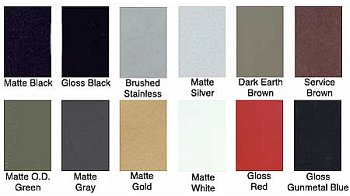Spray-On Finish 'How-To' Videos
In recent years, spray-on finishes have become a popular alternative to traditional blueing for chrome-moly barrels and receivers, plus other gun parts. Spray-on finishes provide excellent rust-proofing, some degree of abrasion resistance, and many of the finishes also provide increased lubricity for moving parts. (Be aware, however, that these finishes go on thin, and the finish can wear through on high-abrasion areas, such as slide rails on pistols.)
Matte spray-on products work well for hunters looking for a dull, non-glossy finish that blends into the background. A bake-on polymer-type finish is a very good choice for a shotgun or rifle used in the winter or in damp environments (such as duck blinds).
Brownells has created a Six-part series of videos that explain, step by step, how to apply a spray-on finish to gun parts. In Parts I & II, Brownells gunsmith Dave Bennetts explains the basics of spray-on finishes, then shows how to properly prep metal parts for finishing.
In the next four videos, Bennetts provides specific application instructions for four different spray-on gun finish products. Bennetts explains the strengths and weaknesses of each product for particular firearm types. Click the links below to watch the specific product videos:
Spray-on Finish – Chapter 3 – Baking Lacquer
Spray-on Finish – Chapter 4 – Gun-Kote
Spray-on Finish – Chapter 5 – Teflon-Moly
Spray-on Finish – Chapter 6 – Aluma-Hyde II
Of the four featured products, Gun-Kote, sold by Brownells under license from KG Industries, offers superior corrosion resistance, and is probably the most popular of the four products for use on rifles. Gun-Kote was originally developed for the military and was first used by Navy SEALS. Gun-Kote is an “oven-cure” finish applied to pre-heated metal. Though it goes on thin, Gun Kote cures to a hard coating that resists abrasion and won’t wear through as easily as bluing or chemically blackened surface treatments. Brownells Gun-Kote is offered in a wide variety of colors, shown below.




















I use K-G Kote almost exclusively. I infered a trick from “The Arizona Gunplumber” at Arizona Tactical Response Systems. After careful surface preparation: 1. 120 grit AlO2 at moderate pressure. 2. Manganese phosphate “Parkerizing” for chrome moly parts or some form of mild pickling for the EXTERIOR of stainless steel parts. 3. Degrease with acetone or some other noxious substance (I prefer something nasty under a fume hood, or wearing a mask in a dustless breeze (send wife shopping; church doesn’t last long enough). 4. Spray on Gun-Kote gray (some sources refer to it as a military gray-green). 5. Bake it at 350 degrees F for one half hour longer than spcified in the instructions. 6. The part will look like a thirty year old milspec manganese “parkerized” piece.
When I built M-16 uppers for my son’s for their deployments to Iraq and Afgahistan they had high quaility 16″ Recce style barrels (that looked thirty years old) under Larue Tactical free float tubes that we drug in the dirt for a mile behind the pick-up truck.
Anyway, the product looks like old issue, but shots 1/2 MOA day in and day out.
It is a PITA, but a remarkable digital camo job can be done that will work in 90% of the envirnments out there. I spray the interior parts with a color that shows up on the dirt if you drop them. Finally I lube everything with that Teff Dri stuff from Bore tech. When the bolt group and carier get gunked up I try to find an ultrasonic cleaner to borrow. Otherwise the KG-! carbon solvent works pretty well. I cut up a green follower to make a scraper – keep it sharp.
Thankst to the Arizona Gunplumber for so freely sharing his knowledge. His work is top drawer.
lawndart